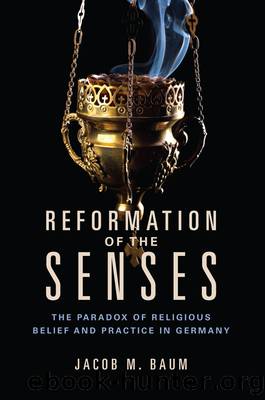Reformation of the Senses by Baum Jacob M.;

Author:Baum, Jacob M.;
Language: eng
Format: epub
Publisher: University of Illinois Press
Published: 2018-07-14T16:00:00+00:00
6Thinking with the Senses in the Second Reformation
When Johann Sigismund, margrave and lector of Brandenburg, received Communion on Christmas Day 1613, things were noticeably different. Gone was the traditional Eucharist wafer, elevated and on display for the adoration of devoted communicants. Gone, too, was the ornamentation at the altar, sensuous vestiges of traditional Christianity lingering in many of the churches across Lutheran Germany. The Berlin Cathedral had been stripped bare of virtually all of the distinctive visual appeal of Lutheran worship. The elector and his ministers had even gone so far as to do away with beloved Lutheran hymns, reported Simon Gedicke, a Lutheran chaplain and eyewitness to Johann Sigismund’s Communion. What was left was a bare table, covered in white velvet, upon which had been laid a plain loaf of bread. The bread was torn into pieces. Johann Sigismund approached the table, took a small piece of bread in his hand, ate it, sipped from a cup of wine, and returned to his seat. Along with him, Gedicke reported, “about fifty people communed.”1
The elector of Brandenburg had used the Christmas Communion services in 1613 to mark his public conversion to reformed, or Calvinist, Christianity, but he had likely already converted privately as early as 1606. In the first years of the seventeenth century, he had spent considerable time at the court of the Counts of the Palatinate, in the city of Heidelberg. By then, Heidelberg was recognized as the epicenter of German Calvinism in the Holy Roman Empire. Since the conversion of Frederick III (1515–1576, r. 1559–1576), the Counts Palatine, along with leading intellectuals in the University of Heidelberg, had vigorously supported the spread of a decidedly Calvinist variety of reformed Christianity, particularly in those areas that had converted to Lutheranism earlier in the sixteenth century. From Heidelberg’s situation in the southwestern corner of the Empire, the new religion radiated north and east, taking hold mainly among nobility and intellectuals but generating controversy and conflict within the Protestant community more broadly. This was a distinct, new era in the history of the German Reformation. As those reformed Christians who led the charge saw it, they were enacting a reformation of the Reformation, or a “Second Reformation.”2 Both sides, Lutheran and Calvinist alike, saw ritual as the frontline of this new battle. In many respects Johann Sigismund’s Communion in 1613 marked the culmination of the Second Reformation: German Calvinism would spread no further beyond the ruling class of Brandenburg, which sprawled across the northeastern plains of the empire. Unlike other princes who converted, Johann Sigismund never attempted to impose the new faith on the populace; he hoped, rather, to persuade them, employing professors and theologians from across the empire to spearhead a propaganda campaign on behalf of the new religion. He failed in this respect, and henceforth the Calvinist margraves of Brandenburg would rule over Lutheran subjects.
We often think about the ritual controversies that erupted during the Second Reformation as struggles over markers of confessional identities and, as such, central to the exercise of power by Lutheran and Calvinist authorities.
Download
This site does not store any files on its server. We only index and link to content provided by other sites. Please contact the content providers to delete copyright contents if any and email us, we'll remove relevant links or contents immediately.
Angels by Billy Graham(1852)
How To Be Born Again by Billy Graham(1683)
Peace with God by Billy Graham(1584)
Unbroken Curses by Rebecca Brown & Daniel Yoder(1472)
God's Prophetic Symbolism in Everyday Life by Adam Thompson & Adrian Beale(1394)
The School of Biblical Evangelism by Ray Comfort(1338)
Martin Luther: The Man Who Rediscovered God and Changed the World by Eric Metaxas(1321)
Call by Rick Joyner(1314)
Power over the Enemy by John Osteen & Joel Osteen(1281)
Jonathan Edwards: A Life by Marsden George M(1156)
The Supernatural Power of a Transformed Mind Expanded Edition: Access to a Life of Miracles by Bill Johnson(1142)
Prayers That Bring Healing and Activate Blessings: Experience the Protection, Power, and Favor of God by John Eckhardt(1141)
Fresh Wind, Fresh Fire by Jim Cymbala(1134)
Unmasking the Devil: Strategies to Defeat Eternity's Greatest Enemy by John Ramirez(1128)
An Altar in the World by Barbara Brown Taylor(1117)
Reformation Theology by Littlejohn Bradford(1094)
Liturgy of the Ordinary by Tish Harrison Warren(1089)
Seeing the Voice of God: What God Is Telling You through Dreams and Visions by Smith Laura Harris(1071)
Martin Luther by Mansch Larry D.; Peters Curtis H.;(1070)
